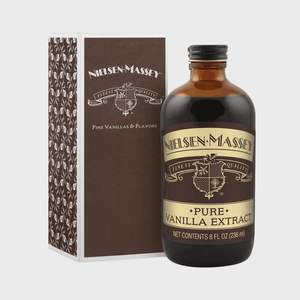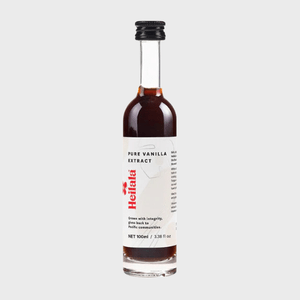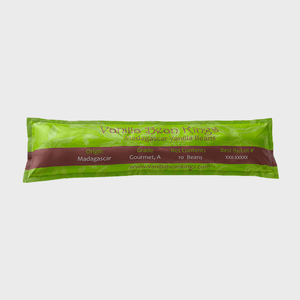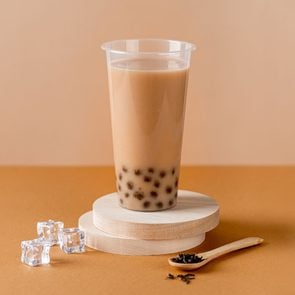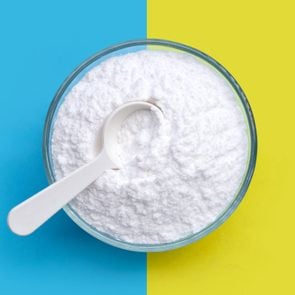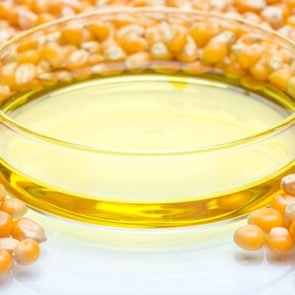Where Does Vanilla Flavoring Come From?
Updated: Jun. 06, 2023
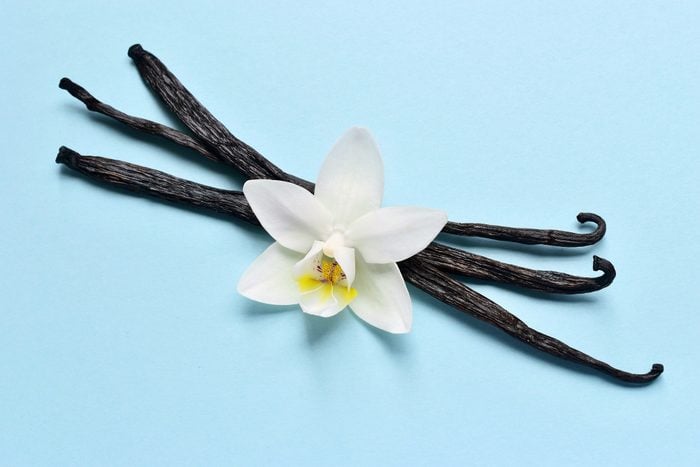
Get to know vanilla flavoring and its tricky twin, artificial vanilla flavor.
In a world of endless flavor possibilities, there’s something so comforting about vanilla. It’s not nearly as exciting as umami and doesn’t defy logic like the taste of McDonald’s Sprite, but it has been used for centuries and has stood the test of time. Here’s a fun food fact for you: Vanilla flavoring made an appearance in Thomas Jefferson’s ice cream recipe, and to this day, you’ll find it in ice cream, cookies, marshmallows, and more. Which begs the question: Where does vanilla flavoring come from?
We’re breaking down the basics—from the origins of vanilla, to how it’s made, to why it’s so expensive.
What is vanilla flavoring made from?
Before we get into vanilla extract in all its forms, you need to know how the flavoring begins. True vanilla comes from the seeds of a specific orchid belonging to the Vanilla genus. Although there are more than a hundred kinds of vanilla orchids, only two yield the seed pods that are used in vanilla extract: Vanilla planifolia and Vanilla tahitensis. The seed of this orchid (aka the pod) is known commercially as the vanilla bean. But it’s not actually a bean; the plant doesn’t belong to the legume family.
In a favorable growing environment, the vanilla orchid will attach itself to trees in order to grow. It’s not a parasitic plant like mistletoe, and it doesn’t damage the host tree. Its white, spongy roots wrap themselves around the tree bark and, along with the flower’s fleshy leaves, absorb moisture from the humid air, helping the orchid grow.
According to the American Orchid Society, vanilla orchids bloom for a shorter time than the orchids commonly seen in flower arrangements, which can last several weeks. Flowers on the vanilla orchid plant bloom one at a time, each staying open for only one day.
Where is vanilla grown?
Vanilla orchids are native to Mexico, where they were originally enjoyed by the Maya and were later grown by the Totonac people of present-day Veracruz. As far back in pre-Columbian times, vanilla was used alongside cacao beans to flavor chocolate.
Although European conquerors tried to grow this orchid, they didn’t succeed. That’s because it grows in a narrow geographic belt—between the 10th and 20th parallels north and south of the equator, except in Australia—and is pollinated by bees native to Mexico.
Where does vanilla flavoring come from today? Most commercially available vanilla is sourced from Mexico, Madagascar, and Tahiti. But you may find vanilla from India, Indonesia, Uganda, Papua New Guinea, and parts of South America too. (Just be sure you know how long spices last before stocking up!)
Where does pure vanilla extract come from?
Vanilla pods reach their fully matured size eight to nine months after the flowers are pollinated. When the pods still have a yellow-green tip, they are harvested. Unlike the flowers, which are fragrant before the pods are formed, the pods have no aroma of their own—yet.
Producers then cure the vanilla pods by either dipping them in hot water, sun-drying them, or allowing them to sweat and mature over the next several weeks. During this time, the pods oxidize and change from green to mahogany. They also become skinny and gain the classic vanilla aroma and flavor, thanks to a compound called vanillin.
Soaking these pods in alcohol extracts the flavor, creating—you guessed it—vanilla extract. The Food and Drug Administration (FDA) defines pure vanilla extract as a mix of vanilla scent and flavor in alcohol. In fact, to be considered vanilla extract by the FDA, a product has to contain at least 35 percent alcohol by volume.
Can I make my own vanilla flavoring?
There are many easy ways to make vanilla extract at home. For a quick infusion, slice open a vanilla bean and immerse it in water or milk to extract the flavor.
For a richer vanilla extract, immerse the cut beans in a good-quality vodka or rum and allow the flavors to develop over a few weeks. This yields a fine quality of pure vanilla extract. Don’t be surprised if you end up doubling the vanilla in your baked goods for even more of its delicious flavor. Here are a few tips for making infused vodka.
But if you buy vanilla beans, you don’t have to restrict yourself to vanilla extract. You can use the seeds themselves while cooking. Simply cut open the pod and scrape the tiny seeds out. Then add them to a dish.
Why is vanilla so expensive?
Like all orchids, wild vanilla relies on specific insects for pollination: Melipona bees and Euglema bees. Both are native to Mexico, which is why all commercial vanilla is laboriously hand-pollinated during a small window of time. Interestingly, this method of hand-pollinating vanilla to produce vanilla pods was discovered by Edmond Albius, a 12-year-old Madagascan boy born into slavery in 1841.
As you’ve probably guessed, the limited growing regions and labor-intensive processes of growing, harvesting, and processing vanilla pods mean good-quality pure vanilla extract can be expensive. Saffron may be the most expensive spice, but vanilla is close behind.
What is artificial vanilla flavoring made from?
We all love vanilla, which sounds like a good thing, until you consider that supply can’t always keep up with demand. To get around that and the cost of production, researchers have developed cheaper versions of vanillin, the compound that gives vanilla its characteristic flavor. And this stuff doesn’t come from the vanilla plant.
This is called imitation vanilla, and it’s used as a fragrance in products like perfumes, candles, and potpourri and as a flavoring in cookies, cakes, candy, cereal, and more. Most imitation vanilla is derived from petroleum, created as a byproduct of processing rice bran oil, or obtained by extracting vanillin from items like cloves, wood pulp, and castoreum (excreted from beavers).
Wait, what’s that about beaver vanilla?
When you google “where does vanilla flavoring come from,” you probably don’t expect beavers to be involved. There’s no palatable way to put it: Castoreum, which has been for years as a food additive, is a substance secreted by a gland close to the beaver’s butt. Hence the nickname beaver vanilla. The FDA says castoreum in food is generally safe, and the agency permits its use in products under the label of imitation vanilla or artificial vanilla flavor.
Is there a difference between imitation vanilla and vanilla extract?
The difference between these two products is in how they’re made. Pure vanilla extract is, as the name implies, extracted from vanilla pods that come from the vanilla orchid. Imitation vanilla, on the other hand, doesn’t come from the vanilla plant. Despite their labor-intensive processing, whole vanilla bean pods (and the pure extract made from them) are increasingly preferred over imitation vanilla.
With so many nuanced variations in how vanilla is sourced and used, it’s no wonder that even something as simple as vanilla ice cream tastes different based not only on the brand you’re eating but also the country you’re in.
How do I choose a good vanilla flavoring?
Knowing the answer to “where does vanilla flavoring come from?” is a good first step, but to choose a good vanilla extract, ask yourself “how does this vanilla smell?”
Ethan Frisch, cofounder of spice purveyor Burlap and Barrel, says the quality of vanilla pods depends on the care applied to the pods during the curing process. “Good vanilla pods should smell rich and sweet, with notes of chocolate, dried fruit, and cream,” he says.
The plant your vanilla came from matters too. Both Vanilla planifolia and Vanilla tahitensis differ slightly in their aromas. “While planifolia has a deeper, more chocolaty aroma and flavor, tahitensis is lighter, more floral, and more woodsy.”
Next time you’re browsing the spice aisle, be sure to pay attention to the type of vanilla you’re dropping in your cart. And keep learning more about the foods you eat by reading all about bubble tea, your soon-to-be favorite drink.
Sources:
- Ethan Frisch, of spice purveyor Burlap and Barrel
- Agronomie: “Vanilla planifolia: history, botany and culture in Reunion island”
- Hispanic American Historical Review: “The culture history of Mexican vanilla”
- American Orchid Society: “Pollinating the Vanilla Flower”

